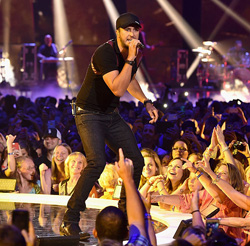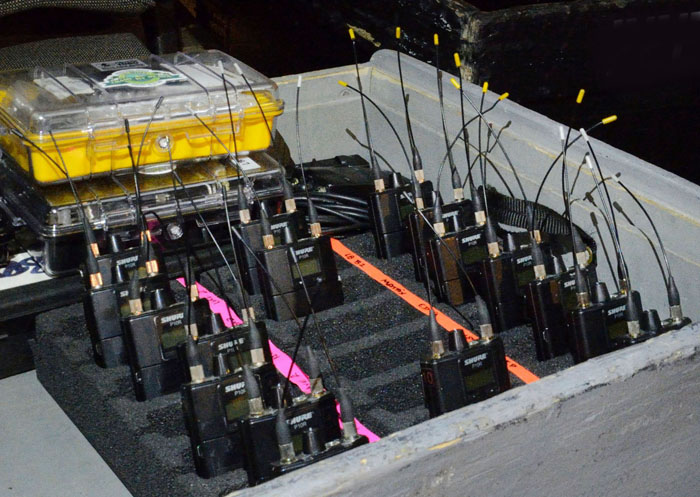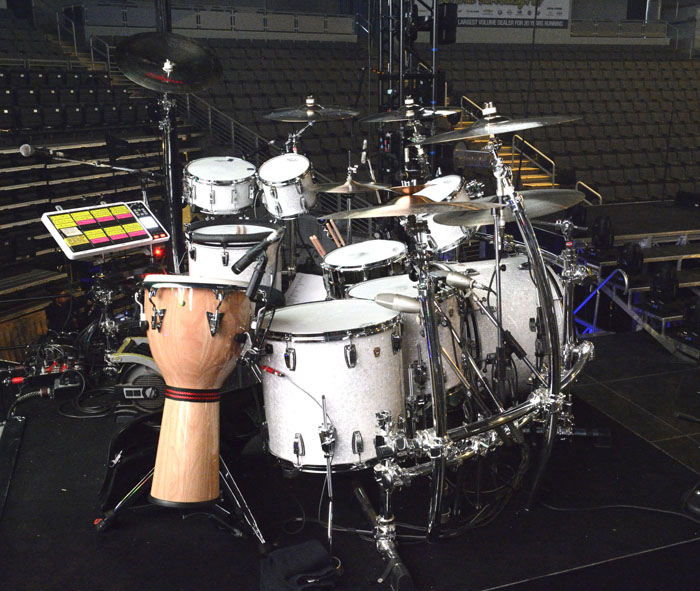
Shrinking & Growing
Healey made the big switch from analog to digital at the beginning of this year with the addition of a DiGiCo SD5. What prompted the move?
“Every one of Luke’s shows are sold out,” he replies. “And our FOH footprint had grown incredibly large, so we needed room for more seats. I was carrying a Midas XL4 for the last three years, and had an Avid Profile set up as a sidecar for everything that wouldn’t fit on my main board. That alone took up 16 by 12 feet of the footprint, and then we had the two support acts’ consoles, camera positions, motion control, and lighting world.
“Before we knew it our footprint was 30 feet wide and 24 feet deep. We had to do something to reduce it all, so although I loved it dearly and often miss it, the XL4 had to go.”
The switch to the SD5 followed a “shoot-out” comparison of several different digital consoles at the Clair Global facilities. In addition, monitor engineer Janiszewski had been using a DiGiCo SD7 and really enjoyed it. “So I talked it over with the folks at Clair and with Frank (Sgambellone), and it kept coming back to the SD5,” Healey says. “We decided it was the most stable platform out there and had the best sonics.”
He’s now running more than 90 channels per show, including production inputs and highly specific inputs for tasks like triggering side-chain compression for the toms, with two SD racks and audio networked over fiber. (By the way, touring partners Little Big Town and Dustin Lynch are also utilizing SD consoles for both house and monitors.)
Much of Healey’s collection of outboard gear went the way of his former console. Surviving the cut is an effects rack dominated by TC Electronic gear that includes a D-Two multitap rhythm delay, 2290 stereo panning delay, pair of M3000 studio reverbs, an M2000 dual-engine studio effects processor, and an M5000 mainframe multi-effects unit.
The M5000 finds its way into Bryan’s vocals, while one M3000 is for snare, and the other is for toms. The M2000 is doing acoustic guitar, fiddle, and such; the 2290 takes its turns on specific long delays, and the D-Two is Healey’s everyday utility delay because it’s quick and fast. Everything else – gates, comps, you name it – now resides onboard the SD5.
Monitor Orchestrations
As noted, Janiszewski works with an SD7, a board he appreciates for its power and surface template, which he feels makes more channels available, provides more access to the things on those channels, and, in his words, “is very configurable.”

Bryan wears Sensaphonics 2MAX earphones with his Shure PSM 1000 personal monitoring system, while among the rest of the band, we find Jerry Harvey JH16 and Clear Tune earphones. Like Healey, outboard effects are still part of Janiszewski’s creative palette. A TC M3000 is in his collection, as well as an Eventide Eclipse and a pair of Yamaha SPX1000 multi-effects units. All of these devices are utilized for Bryan’s vocals as well as other vocal processing because Janiszewski notes they do things not available with the SD7’s internals.
“And I’m not running Waves,” he adds. “My band guys, for the most part, get a specific mix with themselves over the top and whatever else they need to keep up with that. Some of the mixes are fuller, some are more stripped down.”
Bryan’s mix is the fullest of the lot. “When I first started I built him a live album-type mix with him on top,” Janiszewski recalls, “figuring we’d work with it in a sound check kind of fashion over time where we’d stop and fix some things during rehearsals or whenever. After the first day I told him I’d be glad to talk about whatever he wanted to change and then take care of it. He told me ‘I’ll let you know.’ He came offstage not long after that, handed me his ear buds and said ‘good.’ That was the end of it. I kept waiting to make some changes, but he never asked for any.”
Getting Along
Bryan has a rich, deep voice, and is capable of singing in multiple octaves. On the low-end he’s a solid baritone, moving nicely into the lower side of a tenor when he wants to, and even going for it with a strong falsetto if he’s goofing around or reaching for a high note. Known just as much for great mic technique that delivers an excellent signal to both Healey and Janiszewski at all times, he never leaves either chasing him with the faders all night to keep things in line.
The show has its peaks and valleys, sometimes sitting right at 98 dB SPL (A-weighted), other times idling at 102 and then peaking at 106 dB. “Sound reinforcement is what we do,” Healey concludes. “I’ve never been one that wants to put on a show and have everyone sitting there quietly. At our shows everyone is on their feet all night all the way up to the upper deck.
“We’ve metered the audience screaming between songs at 118 dB A-weighted with nothing come through the PA. If that’s any measure of success, I’d say we’re getting along quite nicely.”
Gregory A. DeTogne is a writer and editor who has served the pro audio industry for the past 32 years.


